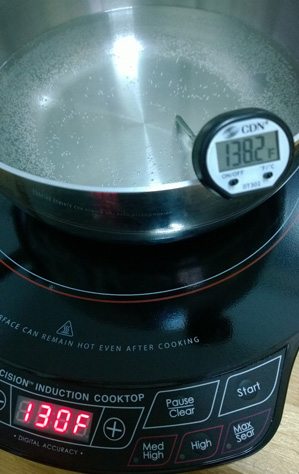Induction Cooking
What is induction cooking
Induction cooking is a method of cooking that uses induction heating to directly heat a cooking vessel, as opposed to using heat transfer from electrical coils or burning gas as with a traditional cooking stove. To be used on an induction cooktop, a cooking vessel must be made of a ferromagnetic metal, or placed on an interface disk which enables non-induction cookware to be used on induction cooking surfaces. It is easy to know if your cooking vessel is ferromagnetic since it will stick to any magnet (such as those often used to stick to home refrigerator doors.
Advantages of Induction Cooking:
-- An induction cooker is faster and more energy-efficient than a traditional electric cooking surface. It allows instant control of cooking energy similar to gas burners.
-- Because the surface of the cook top is only heated from contact with the vessel, the possibility of burn injury is significantly less than with other methods.- energy is supplied directly to the cooking vessel by the magnetic field so most of the source energy gets transferred to that vessel.
--stove top stays cool
Disadvantages of Induction Cooking:
-- the pot can heat up very quickly, so there is a learning curve on controlling the heat
-- only ferromagnetic pots can be used. glass and aluminum pots will not work--Cooking vessels at the extremes of size--the very small and the very large--occasionally raise issues--(the usual minimum pot base size for activation is from 4 to 5 inches, depending on particular unit.) But that is scarcely a major issue: if you really must have such a pot--say "a butter warmer"--there are accessories available that make it easy.
--It's expensive. In comparison to gas or electric stoves, an induction setup is likely to cost you considerably more
--the magnetic nature of the process may make your cookware a bit noisy. When used on high power settings, the magnetic field may vibrate loose pan handles or lids on pots, and it may even cause some lower-quality cookware or cookware with an uneven bottom surface to rock, rattle or buzz when cooking.
-- induction stoves are not recommended for those who have pacemakers since the magnetic fields may interfere with the device.
 Note that temperatures are not as accurate as when cooking sous vide.
Note that temperatures are not as accurate as when cooking sous vide.
When is induction cooking very useful in cooking?
1) Sauces e.g., butter sauces or butter poaching requires that the butter (sauce) be kept below 160F unless a beurre monte is made which will allow higher temperatures before breaking. This is difficult to control using a gas or electric stove. Using an induction cooktop the temperature can be controlled usually within 5-10 degree F.
2) shortened amount of time needed to preheat or cook food on the stovetop. Pasta can be cooked in half the time.
3) The induction stove can be used for slow cooking (see science of slow cooking) stews or vacuum packing bags immersed in a water bath to replace a sous vide cooker (see science of sous vide cooking). Note: While sous vide method is possible the water temperature must be carefully monitored till you you become familiar with you stove temperatures. (Note: some recipes may be difficult if they require maintaining a temperature within a very small value).
4) Melting Chocolate - Set temperature to 115F and you can melt your chocolate directly in a pan without using a double boiler.
Chefs Signature Recipes
- Joel Robuchon -- Pomme Puree
- Fusilli, Red Wine-braised Octopus - Micahel White
- Sea Bass en Paupiette- Daniel Boulud
- Chocolate Molten Cake-Jean George
- Salmon Sorrel Sauce - Troisgros
- Scallops on Cauliflower Puree with White Raisin - Gordon Ramsay
- Lobster, Red Pepper - George Blanc
Featured Recipes
- Pan Seared Black Sea Bass with Pea and Jalepeno Sauce
- Carrot Soup with Ginger and Curry
- Grrenmarket Bouillabaisse
- Cold Cucumber Soup Tuna Tartare
- Baked Eggs (En Cocotte)
- Seared Salmon with Brussel Sprouts, Mustard Sauce
- Seared Scallops with Swiss Chard, Bacon and Monkfish Liver Sauce